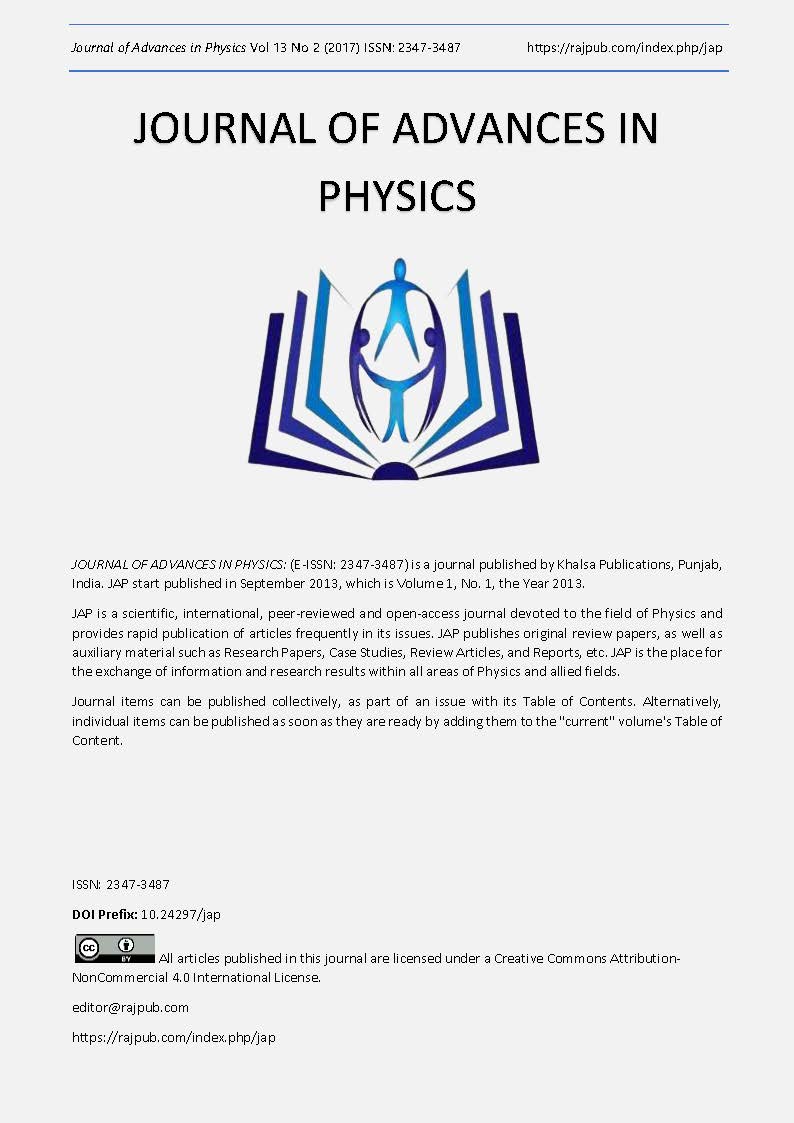Green synthesis of mixed metallic nanoparticles using room temperature self-assembly
DOI:
https://doi.org/10.24297/jap.v13i2.5942Keywords:
Silver nanoparticles; gold nanoparticles; Bimetallic nanoparticles; X-ray diffraction; transmission electron microscopy; Bimetallic nanoparticles; Ag/Au; TEM; XRD; EDAXAbstract
Bimetallic nanoparticles of silver (Ag) and gold (Au) were synthesized at room temperature using Curcumin. Reduction process of silver and gold ions with different molar ratios leads to production of different nanostructures including alloys and core-shells. Produced nanoparticles were characterized simultaneously with FTIR, UV/vis. spectroscopy, transmission electron microscopy (TEM), and Energy-dispersive X-ray (EDAX). UV/vis. optical absorption spectra of as synthesized nanoparticles reveals presence of surface palsmon resonance (SPR) of both silver at (425 nm) and gold at (540 nm) with small shift and broadness of gold band after mixing with resucing and capping agent in natural extract which suggest presence of bimetallic nano structure (Au/Ag). FTIR and EDAX data approve the presence of bimetallic nano structure combined with curcumin extract. TEM micrographs shows that silver and gold can be synthesized separately in the form of nano particles using curcumin extract. Synthesis of gold nano particles in presence of silver effectively enhance and control formation of bi-metallic structure.
Downloads
References
2. Fan F., Zhang J., Li J., Zhang N., Hong R., Deng X., Tang P., Li D. 2017 Hydrogen sensing properties of Pt-Au bimetallic nanoparticles loaded on ZnO nanorods. Sensors and Actuators B: Chemical, 241, 895-903
3. Toshima N., Zhang H. 2012 Polymer-Protected and Au-Containing Bi- and Trimetallic Nanoparticles as Novel Catalysts for Glucose Oxidation. Macromol. Symp. 317-318, 149–159.
4. Nikam A.P., Ratnaparkhiand M.P., Chaudhari S.P. 2014 Nanoparticles – An Overview. International Journal of Research and Development in Pharmacy and Life Sciences 3(5),1121-1127.
5. Heera P. and Shanmugam S. 2105 Nanoparticle Characterization and Application: An Overview. Int. J. Curr. Microbiol. App. Sci 4(8), 379-386.
6. S. Hasan 2015 A Review on Nanoparticles: Their Synthesis and Types Research Journal of Recent Sciences (ISC-2014) 4, 1-3.
7. K. J. Rao and S. Paria 2015 Ag–Au–Pd Nanoparticles for Glucose Oxidation and Antimicrobial Applications. Appl. Mater. Interfaces 7(25) 14018–14025.
8. K. J. Rao and S. Paria 2015 ACS Aegle marmelos leaf extract and plant surfactants mediated green synthesis of Au and Ag nanoparticles by optimizing process parameters using Taguchi method. ACS Sustainable Chem. Eng. 3, 483−491.
9. Medynska A.Z., Marchelek M., Diak M., Grabowska E. 2016 Noble metal-based bimetallic nanoparticles: the effect of the structure on the optical, catalytic and photocatalytic properties. Advances in Colloid and Interface Science 229, 80–107.
10. Ghosh S., Nitnavare R., Dewle A., Tomar G.B., Chippalkatti R., More P., Kitture R., Kale S., Bellare J., Chopade B.A. 2015 Novel platinum–palladium bimetallic nanoparticles synthesized by Dioscorea bulbifera: anticancer and antioxidant activities. Int. J. Nanomedicine. 10,7477–7490.
11. Bhawana, Basniwal R.K., Buttar H.S., Jain V.K., Jain N. 2011 Curcumin nanoparticles: preparation, characterization, and antimicrobial study. J. Agric. Food Chem. 59(5), 2056-61.
12. E. Kirubha and P. K. Palanisamy 2014 Green synthesis, characterization of Au–Ag core–shell nanoparticles using gripe water and their applications in nonlinear optics and surface enhanced Raman studies. Adv. Nat. Sci. Nanosci. Nanotechnol. 5, 45-60,
13. A.M. Abdelghany, E.M. Abdelrazek, S.I. Badr, M.A. Morsi, Materials and Design 2016 Effect of gamma-irradiation on (PEO/PVP)/Au nanocomposite: materials for electrochemical and optical applications. 97, 532-543.
14. C. K. Tagad, S. R. Dugasani, R. Aiyer, S. Park, A. Kulkarni, and S. Sabharwal 2013 Green Synthesis of Silver Nanoparticles and Their Application for the Development of Optical Fiber Based Hydrogen Peroxide Sensor, Sensors Actuators B Chem. 183, 144–149
15. A.M. Abdelghany, H.A. ElBatal, Optical and ï-FTIR mapping: A new approach for structural evaluation of V2O5-lithium fluoroborate glasses, Materials and Design 89 (2016) 568–572.
16. M. M. H. Khalil, E. H. Ismail, K. Z. El-Baghdady, and D. Mohamed 2014 Green synthesis of silver nanoparticles using olive leaf extract and its antibacterial activity, Arab. J. Chem. 7, 1131–1139.
17. H. N. Verma, P. Singh, and R. M. Chavan 2014 Gold nanoparticle: synthesis and characterization, Vet. World. 7, 72–77.
Downloads
Published
How to Cite
Issue
Section
License
 All articles published in Journal of Advances in Linguistics are licensed under a Creative Commons Attribution 4.0 International License.
All articles published in Journal of Advances in Linguistics are licensed under a Creative Commons Attribution 4.0 International License.




